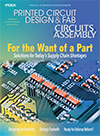News
LOUISVILLE, KY – Sypris Solutions Inc. reported fourth-quarter 2007 revenue of $103.7 million, down 5.3% year-over-year.
SCHAUMBURG, IL – Papers are sought for the International Military & Aerospace/Avionics COTS Conference, Exhibition and Seminar, to be held Aug. 4-6 in Schaumburg, IL.
Papers are sought on commercial plastic-encapsulated components for use in high reliability applications. Specific topics may include reliability; testing; implementation; development; processing; specification generation; procurement (market, sourcing and supply problems); radiation hardness; Pb-free applications, and prognostics.
Abstracts are due April 18 and must include the title, author(s), affiliation and address.
After acceptance, material to be included on a conference proceedings CD is required by July 18.
Papers are sought on commercial plastic-encapsulated components for use in high reliability applications. Specific topics may include reliability; testing; implementation; development; processing; specification generation; procurement (market, sourcing and supply problems); radiation hardness; Pb-free applications, and prognostics.
Abstracts are due April 18 and must include the title, author(s), affiliation and address.
After acceptance, material to be included on a conference proceedings CD is required by July 18.
NORTH BILLERICA, MA – BTU International reported fourth quarter net sales of $18.3 million up 10% year-over-year. Net income for the quarter was $600,000, down 40% year-over-year.


